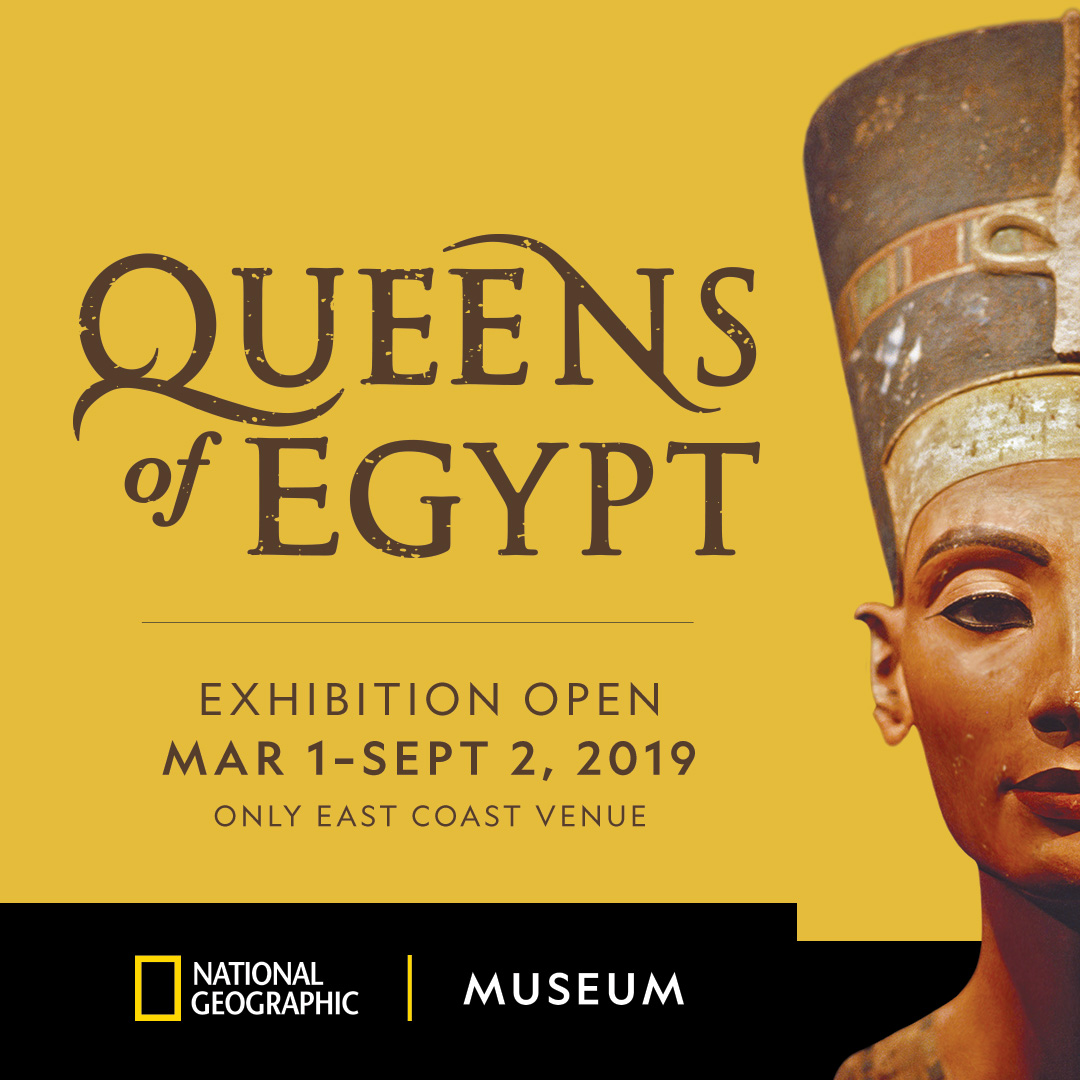
The vast majority of exhibits involving ancient Egypt focuses on the lives and works of men, specifically the male pharaohs. This spring, however, the National Geographic Museum offers a new exhibit and new insights into the lives of those powerful women who ruled ancient Egypt.
The Queens of Egypt exhibit brings the lives and accomplishments of these women closer to us. While some of the some of the women are unquestionably legendary, such as Cleopatra and Nefertari Meritmut, other queens are lesser known, especially to those of us unfamiliar with ancient Egyptian dynasties and culture.
These women were rulers in their own right who had power and authority within the pantheon of Egypt. One of them, Hatsheput, was crowned pharaoh and portrayed with a false beard and masculine clothing to underscore her power and authority. The exhibit does not lose sight, though, that these women were also mothers, daughters, sisters, and companions, not only to the pharaohs, but to the others in their court.

The rarity of an exhibit focused on the power of women required work to pull away from the usual masculine narrative. National Geographic Fellow Frederik Hiebert puts it starkly in an interview with Wall Street Journal: “Egyptian written history is from a man’s point of view.” He notes that while pharaohs were usually married to powerful women, their works were overshadowed by their husbands’.
Queens of Egypt sheds light on the hidden role of women in ancient Egyptian society, including the surprising level of parity they had with their male counterparts. Women could independently access the legal system, own property, and even divorce their husbands. These mundane components of life are part of the exhibits despite the grandeur and power shown in the artifacts. The curators have balanced the extraordinary with the routine, humanizing the display to a scale accessible to us as visitors.
The exhibition explores aspects of ancient Egyptian customs like the harem, which operated in a specific and strict hierarchy but was also a critical part of the economic life of the pharaoh’s court. Although modern understanding of ancient harems is still incomplete, their functioning and purpose was clear; while the harem served for procreation of the pharaonic line, it also maintained the court, patronized craftspeople, and served as musical entertainment.
The current exhibit is the result of the work of Egyptologist Dr. Kara Cooney, professor of Egyptian art and architecture at the University of California – Los Angeles. She specializes in the study of craft production, coffins, and ancient world economics. Dr. Cooney explores female leadership of Egypt in her book When Women Ruled the World. “Do women rule differently than men do?” asks Dr. Cooney when she explains what questions drive her work. “Why are human beings so hostile to female power? What about ancient Egypt was different?”
These questions were particularly relevant in ancient Egypt. The queens of Egypt served not only as rulers of a state, but rulers of a totalitarian state in a male-dominated society. They were equal in power – equally competent and equally ruthless. Dr. Cooney explores how Egyptian culture offered women opportunities to rise to power, but she also explores the patriarchal obstacles that impeded them.

[Caroline Thibault, National Geographic Museum.]
Queens of Egypt consists of more than 300 artifacts in a 14,000 square foot display. The objects have been compiled from several Canadian and European museums, but relies strongly on loaned items from Italy’s Museo Egizio in Turin.
Thanks to the connection to Museo Egizio, the New Kingdom queen Nefertari steals the show. Her tomb was discovered by Ernesto Schiaparelli in the Valley of the Queens in 1904. Often called the “Sistine Chapel of ancient Egypt,” the tomb displayed Nefertari’s wealth, power and beauty. The tomb contained hundreds of artifacts as well as her mummified body. It also featured paintings of Nefertari that ranged from her being welcomed by the gods to playing the boardgame called senet. It was a trove with insights into both divinity and daily life. The exhibition simulates the Valley of the Queens and the tomb itself in virtual reality.
The exhibit finished its North American premiere a few months ago at the Pointe-à-Callière Montréal Archaeology and History Complex and has now opened at the National Geographic Museum in Washington, D.C. The exhibition began on March 1, 2019 and continues through September 2, 2019. Information about the National Geographic Museum including directions and resources are available online.
For educators and those teaching about Egyptian religion and history, as a National Geographic exhibition, Queens of Egypt comes with teaching and exploration tools as well. This material is available at various educational levels, and for older students, videos and interviews are also available. Much of the material is available on the National Geographic site for Queens of Egypt, including a guidebook.
The Wild Hunt is not responsible for links to external content.
To join a conversation on this post:
Visit our The Wild Hunt subreddit! Point your favorite browser to https://www.reddit.com/r/The_Wild_Hunt_News/, then click “JOIN”. Make sure to click the bell, too, to be notified of new articles posted to our subreddit.